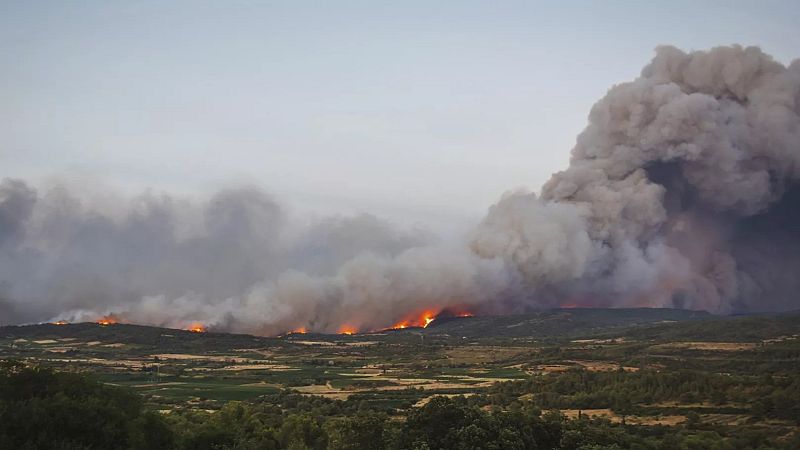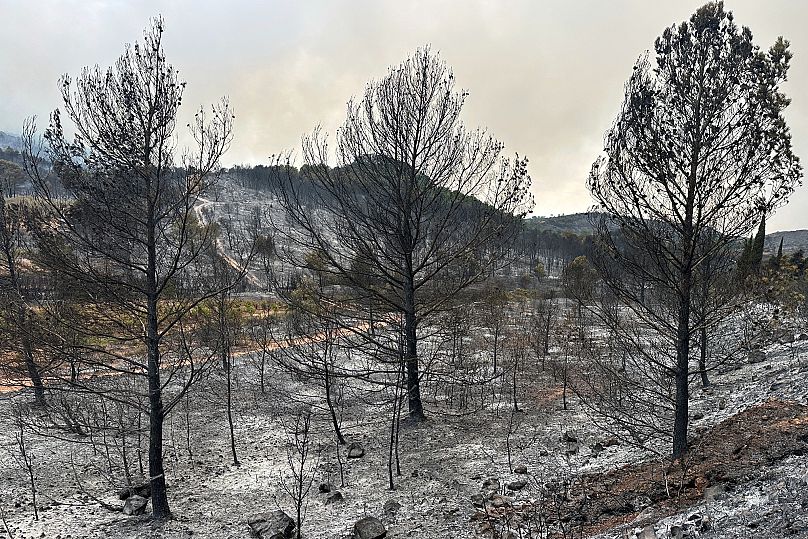
A wildfire burning in the south of France has grown to become the country’s biggest since 1949.
It has claimed one life and burned more than 16,000 hectares - an area one and a half times the size of Paris - in the south of France.
French Prime Minister François Bayrou described it as a “catastrophe of unprecedented scale”.
The blaze, which began on Tuesday afternoon near the village of Ribaute in the Aude region near the border with Spain and not far from the Mediterranean Sea, has been raging for three days.
In the first 12 hours of the fire, it spread across 11,000 hectares of land - an area roughly equivalent to the size of Paris. Within 24 hours, it had destroyed the same amount of land as wildfires usually burn across France in a year.
Now it has burned more than 16,000 hectares to become the biggest fire since the creation of France’s national fire database in 2006, the national emergency management service has said.
Images shared by Météo-France show that the smoke plume from the blaze is visible from space.
France’s largest fire in over 70 years
The fire spread quickly due to strong winds, dry vegetation and hot summer weather, officials have said.
“The night was cooler, so the fire is spreading more slowly but it remains the most significant fire France has seen since 1949,” France’s minister for ecological transition, Agnès Pannier-Runacher, told France Info radio.
“It is a fire that is clearly a consequence of climate change and drought in this region.”
Michael Sabot, deputy director of the Aude fire department, told France's BFM-TV that “unfavourable weather conditions” meant the blaze “certainly” wouldn’t be brought under control on Thursday.
Forecast high temperatures and strong, more than 40km per hour winds would further dry out vegetation, he said. After a cooler start to the week, Météo-France has forecast intensifying heat in the south with temperatures of up to 40°C and a high risk of wildfires.

While current weather conditions play a role, prolonged dry weather has also increased the fire risk.
Mediterranean regions of the country are experiencing significant drought, meaning vegetation and trees are highly susceptible to fires, Météo-France says. It adds that recently, even tall trees have been affected, allowing for very intense fires - a sign of just how severe this drought is.
The Aude region in particular has been facing water use restrictions due to a “drought crisis” since 1 August, with a lack of rainfall in recent months playing “a major role in the spreading of the fire”, according to the environment ministry.
It adds that in the neighbouring Pyrénées-Orientales, rainfall has reduced by around 60 per cent since 2022.
An investigation into the exact cause of the fire is ongoing.
Is climate change fuelling wildfires in the Mediterranean?
This year has so far brought an extremely active and damaging fire season in Europe.
Monitoring from the European Forest Fire Information System shows that wildfires have burned 353,862 hectares of land since the beginning of 2025 - more than twice the area burned during the same period last year.
Hotspots across the Mediterranean have been scorched this summer, stoked by heatwaves and drought. Southern Europe has seen multiple large fires, with scientists warning that climate change is exacerbating the frequency and intensity of heat and dryness, making the region more vulnerable to fires.
According to European Drought Observatory data, more than half of Europe, including the Mediterranean, experienced the worst drought conditions in the first part of July since monitoring began in 2021.
Scientists have warned that climate change is making droughts worse and changing rainfall patterns in Europe. Where regions like the Mediterranean would previously have had a chance to recover, balance or prepare for a lack of water in summer in wetter seasons, they can no longer depend on rainfall in the same way.







